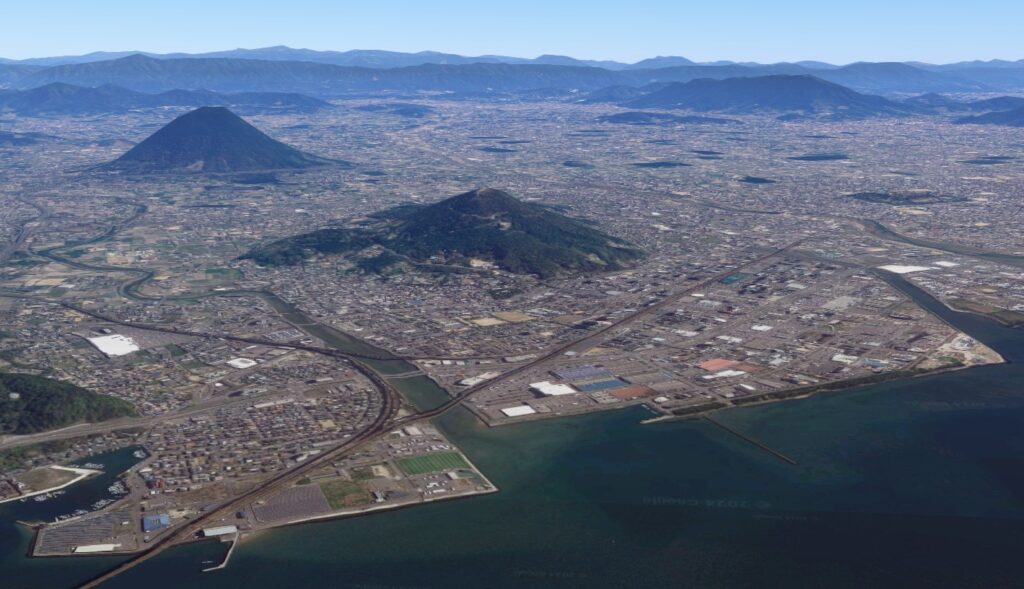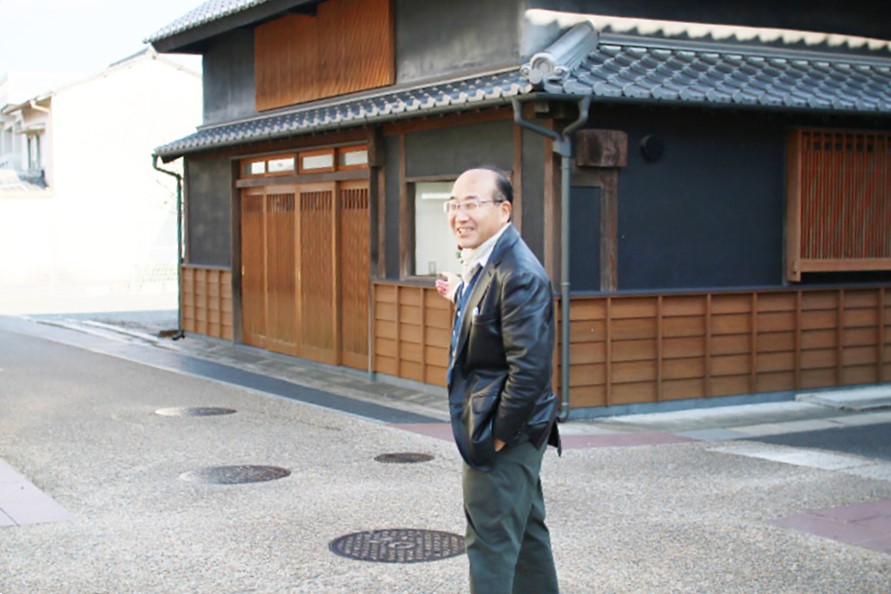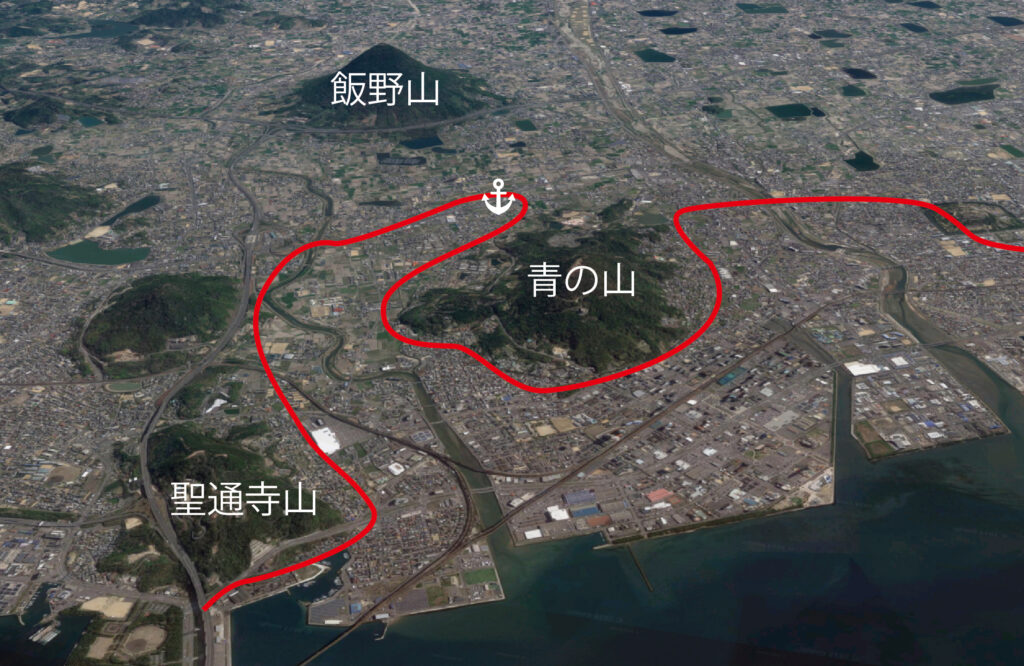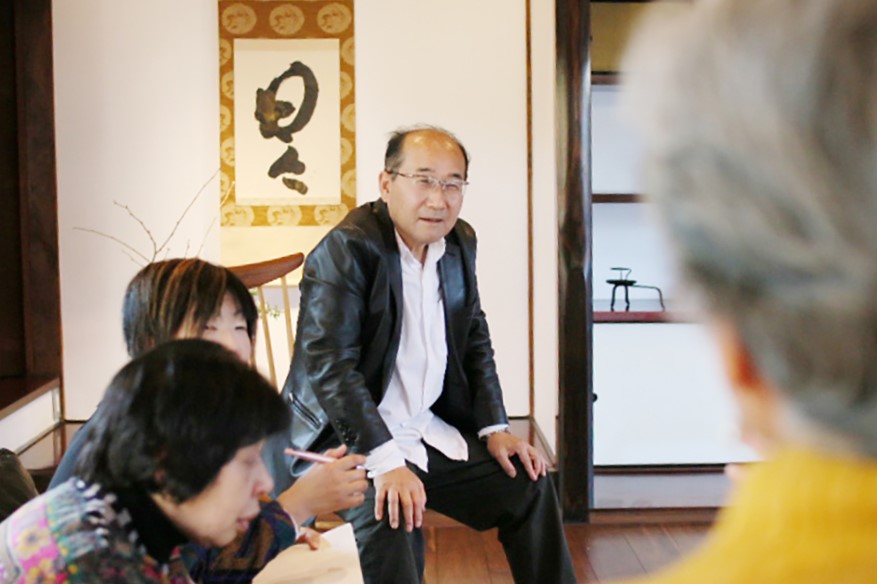香川県沿岸部のおおよそ中央に位置する「宇多津(うたづ)町」。
商業施設やアミューズメント施設が集まる沿岸部の「新都市」と、
昔ながらの街並みを残す「古街(こまち)」が対照的な
中讃地域の中核都市のひとつです。
Utazu Town is located roughly in the center of Kagawa Prefecture’s coastal area.
The town presents a striking contrast between its coastal “New City” district, which is home to commercial and amusement facilities, and its “Komachi” district, where traditional streetscapes have been preserved. As a result, Utazu serves as one of the central cities of the Chūsan region.

引用元:Google社「Google マップ」
キーワードは「海岸線」と「産業」
宇多津は古代より港町として栄え、さまざまな変遷をたどってきました。
歴史を経るごとに海岸線は北進し、街はその都度変容してきました。
また、都への発船の拠点から、船の中継地として、
そして塩の街へと産業も大きく移り変わってきたのです。
このコラムでは、そんな宇多津の街のストーリーを時代ごとに振り返っていきます。
話してくれたのは宇多津町文化財保護協会の畑元(はたはじめ)さん。
“Coastline” and “Industry”
Utazu has flourished as a port town since ancient times, undergoing various transformations throughout its history.
As the centuries passed, the coastline gradually advanced northward, and the town evolved with each change. Likewise, its industries shifted significantly—from serving as a departure point for ships bound for the capital, to becoming a key transit hub for maritime transport, and eventually developing into a major center for salt production.
In this column, we will explore Utazu’s story through different historical periods.
Our guide for this journey is Hajime Hata from the Utazu Town Cultural Heritage Preservation Association.

古街エリアに暮らし、地元の歴史を学んできた畑さんのもとに、
宇多津古街ガイド、ウォーキング・歴史好きな面々が集いました。
大岩本 洋子 うたづの町家とおひなさん会長、宇多津古街ガイド
玉井 幸絵 (株)ちいおりアライアンス、宇多津古街ガイド
西本 祐子 うたづの町家とおひなさん副会長、宇多津古街ガイド
井村 義幸 ウォーキング企画を担当
石川 朋子 (株)ちいおりアライアンス
横田 惠子 宇多津古街ガイド
Living in the historic Komachi district and having studied the local history, Mr. Hata was joined by a group of individuals passionate about guiding, walking, and history in Utazu’s old town.
Participants:
- Yoko Oiwamoto – President of Utazu no Machiya to Ohinasan, Utazu Komachi Guide
- Yukie Tamai – Chiiori Alliance Co., Ltd., Utazu Komachi Guide
- Yuko Nishimoto – Vice President of Utazu no Machiya to Ohinasan, Utazu Komachi Guide
- Yoshiyuki Imura – Walking event coordinator
- Tomoko Ishikawa – Chiiori Alliance Co., Ltd.
- Keiko Yokota – Utazu Komachi Guide
今の宇多津は海の下だった!?
畑さん
宇多津が初めて文献に登場するのは平安時代のこと。
当時の表記は「鵜足津」でした。
これは鵜足(うたり)郡の津(つ:港のこと)であったことを意味します。
このときの海岸線は今より4kmほど南にあったと推定されています。
つまり、今私たちが目にしている宇多津の街は、
まだ海の下に眠っていたということ。
そして青の山付近までは遠浅の海が続いていたようです。
井村さん
青の山は、当時はどんな形だったんでしょうか?今と同じ?
畑さん
青の山は当時は半島のようになっていたと考えられています。
遠くの海からでも見える目印として、昔から船乗りたちに重宝されていました。
さらに半島の手前には穏やかな海が広がっていたため、
自然を活かした良港として機能していました。
Was Utazu Once Beneath the Sea?
Hata-san
Utazu first appeared in historical records during the Heian period. At the time, it was written as “鵜足津” (Utazu), meaning the port (津, tsu) of Utazugun ( Utari District).
The coastline back then is estimated to have been about 4 kilometers further south than it is today. In other words, the land we now recognize as Utazu was still beneath the sea. A shallow sea is believed to have stretched all the way to the area near Aonoyama (Mount Ao).
Imura-san
What did Mount Ao look like back then? Was its shape the same as it is today?
Hata-san
Mount Ao is thought to have been a peninsula at the time. Because it was visible from a great distance out at sea, sailors relied on it as a landmark for navigation.Furthermore, the calm waters in front of the peninsula made it a naturally favorable harbor, allowing it to function as an excellent port.

引用元:Google社「Google マップ」を基に作成。赤線が古代の海岸線(推定)
都と讃岐をつなげる拠点
畑さん
鵜足津からは塩や米、絁(あしぎぬ:絹織物)などが
都へと運ばれていたことが記録されています。
鵜足津周辺には法隆寺の寺領があり、
そこから税としてさまざまな品物が都へと収められていたのです。
玉井さん
鵜足津は古代から、瀬戸内海を通じて日本の中心と密接につながっていたんですね。
A Key Hub Connecting the Capital and Sanuki
Hata-san
Records indicate that goods such as salt, rice, and ashiginu (絁, a type of silk fabric) were transported from Utazu to the capital.
The area around Utazu was once part of the temple estate of Hōryū-ji, and various goods were collected as taxes and sent to the capital from here.
Tamai-san
So, Utazu had strong ties to the heart of Japan through the Seto Inland Sea since ancient times.

横田さん
万葉集にうたわれた「網の浦※」は宇多津なんじゃないか、という説もありますよね。
そのぐらい昔から、宇多津は良いところだと都の人も認識していた、ということかもしれませんね。
Was Utazu the “Ami no Ura” from the Man’yōshū?
Yokota-san
There’s a theory that Ami no Ura (網の浦) mentioned in the Man’yōshū might actually refer to Utazu.
If that’s the case, it suggests that even in ancient times, people in the capital recognized Utazu as a noteworthy place.
※万葉集 第一巻 五番より
「(前略)~網の浦の 海人娘子らが 焼く塩の 思ひぞ焼くる 我が下心~(以下略)」
「(意訳)網の浦の海人娘子(あまおとめ)たちが焼く塩のように、故郷への思いにただ焼け焦がれている。ああ、切ないこの我が胸のうちよ」
(From the Man’yōshū, Volume 1, Poem No. 5)
(Interpretation: “Just like the salt burned by the ama maidens of Ami no Ura, my heart burns with longing for my distant home. Ah, how unbearable this sorrow within me.”)
This poem expresses the poet’s deep yearning for home, comparing their emotions to the salt-making process of the ama (female divers) in Ami no Ura. If Utazu is indeed the Ami no Ura mentioned here, it suggests that the town was already well-known in ancient times for its coastal industry and salt production.
港の歴史② につづく
To Be Continued in “The History of the Port (Part 2)”
Stay tuned as we continue exploring the rich history of Utazu’s port in the next section.